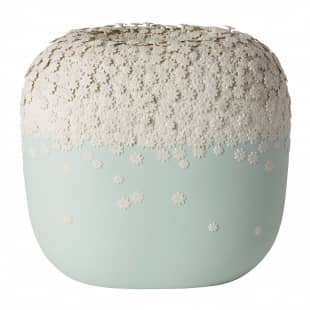
Initially, Hosono worked mainly with black-and-white; now, she is experimenting with soft colors. Hosono mixes the pigment into clay versus using glazes which is why her colors remain so special.
Image courtesy of: Japan Times ,photographed by: Simon Upton
It can be argued that perhaps Hitomi Hosono did as much for Wedgwood as Wedgwood did for her. The Japanese ceramicist was an intern at Wedgwood for ten years. Hosono suddenly had an entire new platform from which to draw ideas. England is quite different than Japan… and this nature lover reveled in the botanicals that were new to her. Lucky for us, she’s beautifully transformed them onto her pieces.
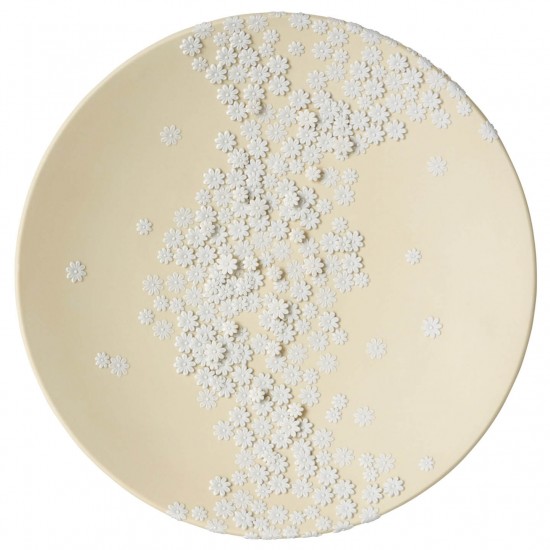
From a limited edition of 5, this Haruka Bowl is adorned with daisies. Chosen from the Wedgwood archives, Hosono was drawn to the daisy because of its tiny and graceful shape and its cheerful “disposition”. The bowl forms a shallow shape which allows Hosono to hand-apply the white bas relief daisies to replicate a flower field.
Image courtesy of: Wedgwood
A little background- last year, Wedgwood taped the very talented Hitomi Hosono as the first artist for their artist-in-residence program. Hosono has come full circle since she was an intern at the Staffordshire factory ten years ago. She learned so much; however, it was the delicate leaves and petals that left an impression on Hosono. These flowers centered her ceramic exploration for the next decade.
Global design director, Dik Delaney, said about the program, “The artisan program is about driving innovation back into the Wedgwood brand through pushing the creative boundaries of the painters and craftspeople at the factories.” Hosono’s vision follows that very premise. Her unique pieces incorporate the new techniques of raised ornamentation, intricate layering, and delicate carving. Sometimes, Hosono even pierces holes into the clay. These are all things that open the doors toward new methods which in turn elicit new creations.
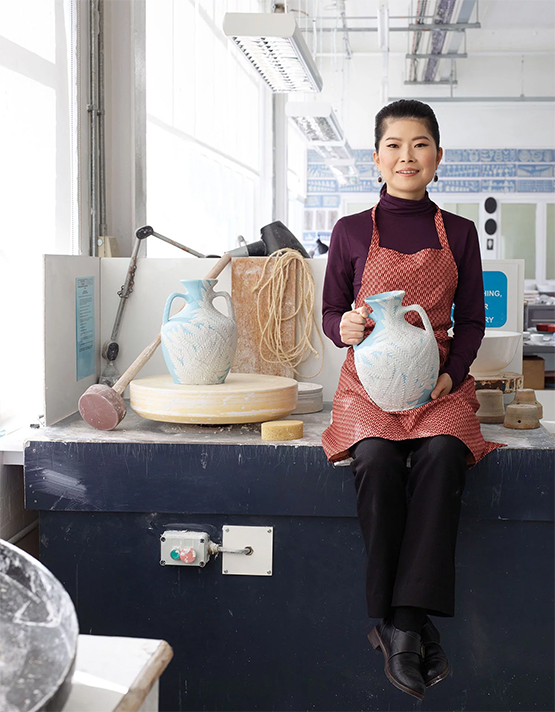
Hitomi Hosono at her London studio.
Image courtesy of: Japan Times, photographed by: Simon Upton
Josiah Wedgwood invented the brand’s iconic jasperware in 1774, the name of which comes from jasper- the natural stone it resembles. Throughout Wedgwood’s long history, the pottery has taken on many colors; most recognizable is their specific shade of blue.
The neo-classical, botanical motifs that Hosono creates to adorn her ceramics are in colors that differ from Wedgwood’s normal color palette. Opting for pastel washes, the colors pay homage to Hosono’s heritage. Wagashi are the elaborate confections that are typically served in Japanese tea houses, the colors of which are usually soft and delicate pastels. We love this color palette on jasperware.
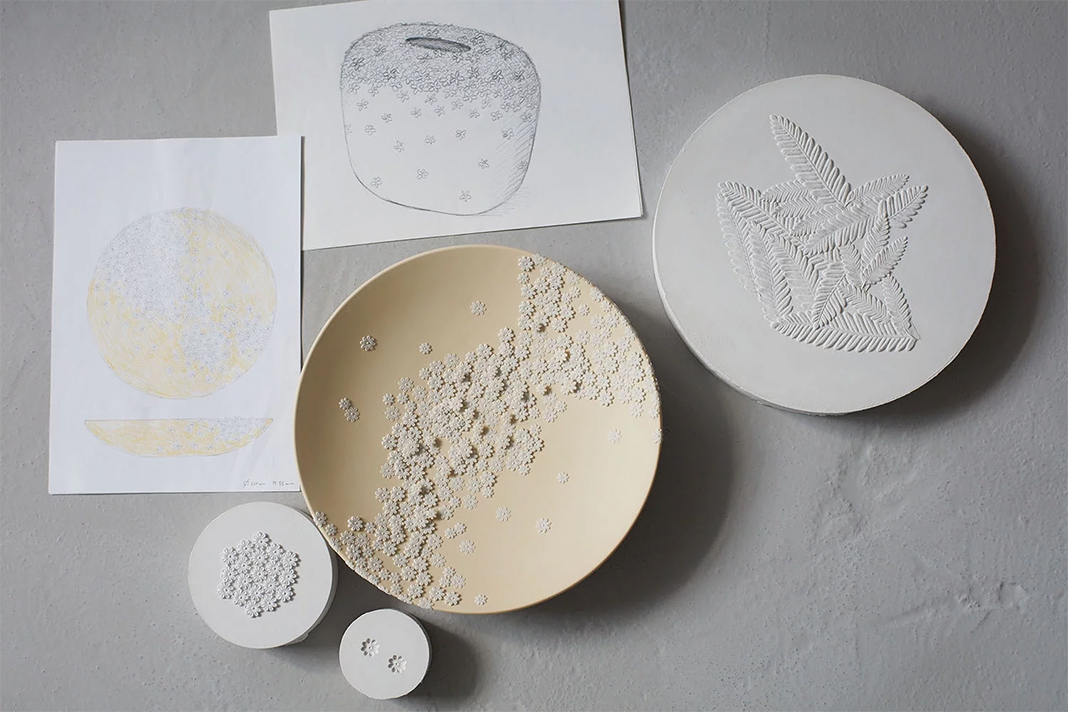
It isn’t a surprise that Hosono is drawn to Wedgwood and decided to go back for a 6-week residency at Wedgwood. Hosono grew up surrounded by tiles and ceramics because her grandfather was a plaster and ceramics worker. She studied traditional ornamental pottery in Japan, moved to study in Denmark, and then Hosono studied at the Royal College of Art in London where she received her Master of Arts degree.
Image courtesy of: Wedgwood
Hosono’s star has risen and she’s now an important artist who has quite a following… The British Museum purchased one of her most recognizable pieces. Nevertheless, since the museum was being sponsored by U.K. charity Act Fund, the curator needed help ensuring the purchase took place.
Hosono describes the experience, “Nicole (the museum’s curator) said I should show them how I made it- how I put the ceramic leaves on. And I used chopsticks to do that. The judge really loved that. It was a little embarrassing because sometimes people want to see something in a work as being a product of me being Japanese, as though that alone is the reason I can do something. In the beginning I resisted this a little, but now I really don’t mind. I have never presented myself as being just Japanese, though. I present myself as Hitomi.”
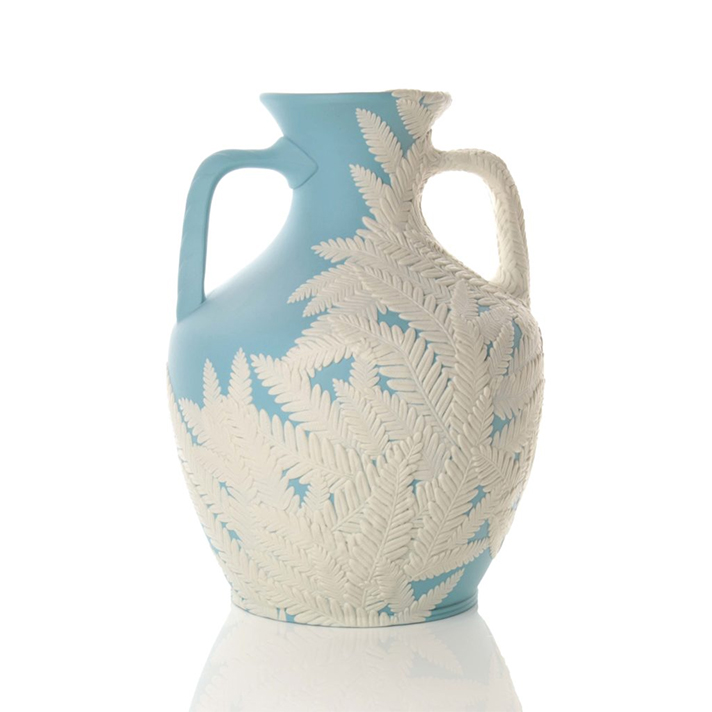
Hosono’s version of the Portland Vase, the Shoka Vase.
Image courtesy of: Adrian Sassoon
One of Wedgwood’s most iconic pieces is the Portland Vase, first exhibited in 1970. This vase was a jasper copy of a cameo-glass vase dating back to the reign of Emperor Augustus Caesar. This vase was initially brought to England by Sir William Hamilton and sold to the Duchess of Portland. The vase remains at the British Museum and now has a compliment in Hosono’s Shoka Vase which retains the urn’s traditional shape. However, the established “Wedgwood blue” has been changed to a sea-blue turquoise; and rather than human forms, Hosono adds ferns as a nod to nature.